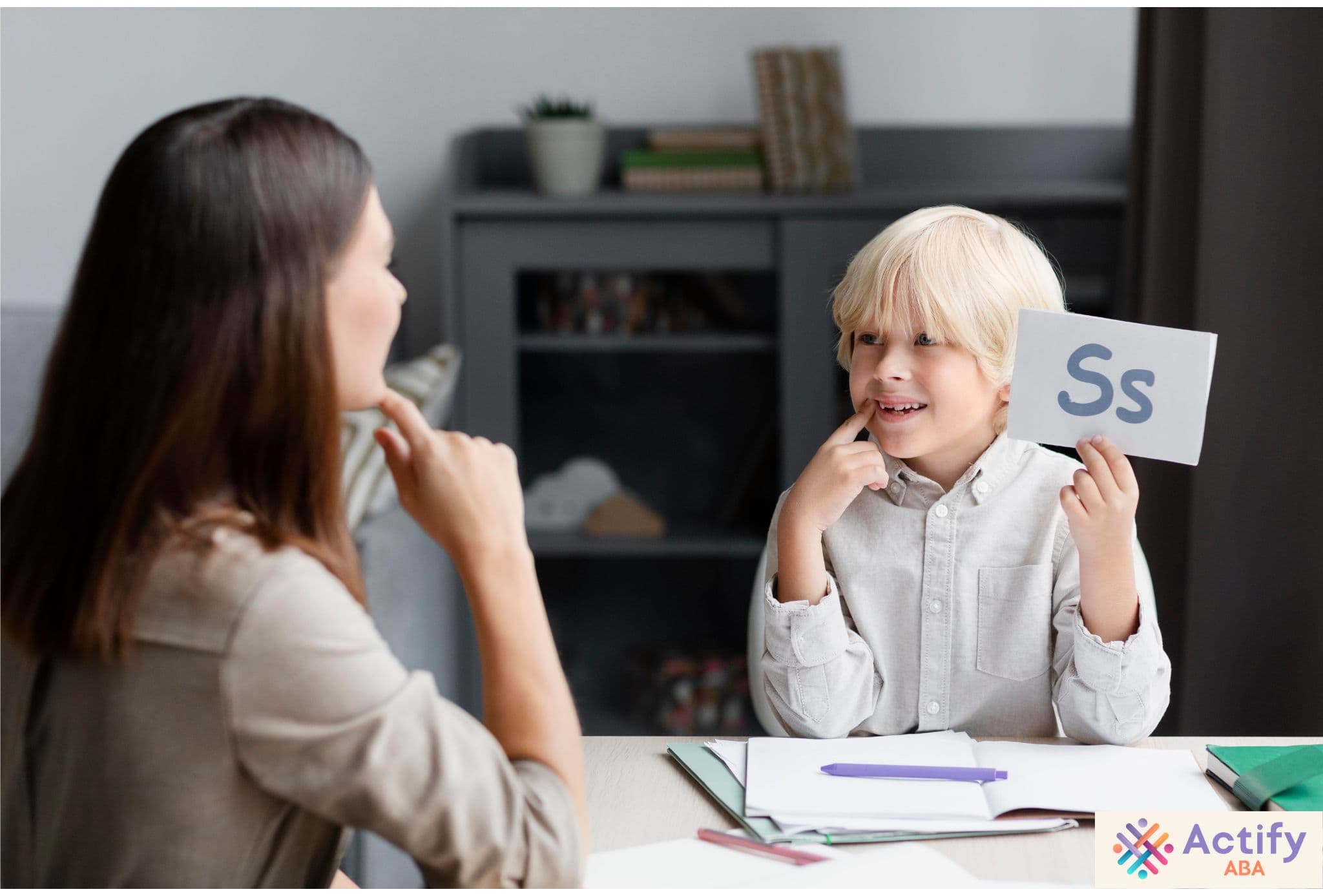
Key Points:
- Nonverbal autism refers to children on the autism spectrum who do not develop functional spoken language.
- Causes may include neurological differences and challenges with motor planning or social communication.
- Support strategies focus on alternative communication methods, early intervention, and individualized therapies.
When a child isn’t speaking by the age when most kids are forming full sentences, it can trigger deep concern. Parents often ask: “Is this a speech delay?” or “Is it something more?” For some children on the autism spectrum, language development never follows the typical path. They may say a few words and then stop. Or they might never speak at all.
This leads many families to search for information about nonverbal autism, what it means, what causes it, and what can be done to help.
This article explains nonverbal autism in clear, practical terms, so you can better understand your child’s experience and explore effective ways to support their communication and development.
What Is Nonverbal Autism?
Nonverbal autism refers to individuals on the autism spectrum who do not use spoken language to communicate functionally. This doesn’t necessarily mean complete silence, but rather that verbal speech is limited or absent for daily needs.
Some children may make sounds, babble, or repeat phrases (echolalia), but they don’t use words in socially meaningful ways. Others may have never developed speech at all.
Being nonverbal is not the same as being unintelligent or unengaged. Many nonverbal individuals understand language, form strong relationships, and express themselves through other means.
Nonverbal vs. Nonspeaking: Is There a Difference?
These terms are often used interchangeably, but there is a subtle difference:
- Nonverbal typically describes someone who does not use spoken words.
- Nonspeaking is a broader, more current term that recognizes someone may be highly expressive but simply does not speak verbally.
For this article, we’ll use “nonverbal autism” to reflect the common search term and understanding among families and caregivers.
Symptoms of Nonverbal Autism
Children with nonverbal autism will typically show core symptoms of autism spectrum disorder (ASD) alongside the absence or limited use of speech.
Here are some common signs:
1. Lack of Functional Speech
- No spoken words used to ask, request, or comment
- May vocalize or babble without clear intention
- May have used words in the past and then stopped
2. Limited Use of Gestures
- Rarely points, waves, or uses other communicative gestures
- May physically guide others’ hands to needs instead of signaling
3. Social Communication Challenges
- Limited eye contact or facial expressions
- Difficulty initiating or maintaining interactions
- May seem unaware of social cues or others’ emotions
4. Repetitive Behaviors or Restricted Interests
- Repeated movements (e.g., hand flapping, rocking)
- Intense focus on specific objects or routines
5. Sensory Sensitivities
- Overreacting or underreacting to sounds, lights, or touch
- Using sensory input (like humming or spinning) for regulation
What Causes Nonverbal Autism?
There is no single cause of nonverbal autism, but researchers believe several factors contribute. Understanding these can help guide realistic expectations and support.
1. Neurological Differences
Brain imaging studies have shown differences in areas of the brain related to language, motor planning, and social interaction in individuals with autism. These may affect a child’s ability to develop and use speech.
2. Motor Planning Challenges (Apraxia of Speech)
Some children with autism may have childhood apraxia of speech, a motor speech disorder where the brain struggles to coordinate the movements needed for speech. This is different from language comprehension; the child may know what they want to say, but can’t physically form the words.
3. Social Communication Deficits
Nonverbal communication and verbal language development are closely linked. If a child has limited joint attention (e.g., pointing to share interest), imitation skills, or social reciprocity, language learning can be delayed or disrupted.
4. Sensory Processing Issues
If a child is overwhelmed by sensory input or doesn’t respond to verbal cues due to sensory filtering issues, they may miss out on key language learning opportunities.
5. Co-Occurring Conditions
In some cases, nonverbal autism may coexist with other conditions like intellectual disability, seizure disorders, or genetic syndromes. These factors can further impact communication development.

Is Nonverbal Autism Common?
Many individuals diagnosed with autism remain minimally verbal or nonverbal past the age of 5. However, it’s important to note that communication exists on a spectrum. Some children who are nonverbal at age 4 may begin speaking later with proper support. Others may always rely on alternative communication.
Can Nonverbal Children with Autism Learn to Communicate?
Absolutely, but it may not always be through spoken words.
Communication is broader than speech. Many nonverbal children learn to express themselves using:
- Augmentative and Alternative Communication (AAC) tools
- Picture Exchange Communication System (PECS)
- Sign language
- Gestures or typed communication
- Assistive technology (e.g., speech-generating devices)
The goal is always to build functional communication, a way for the child to express wants, needs, thoughts, and feelings. Whether it’s spoken or not, that ability changes everything.
Myths and Facts About Nonverbal Autism
There’s a lot of misinformation out there. Let’s clear up a few common myths:
Myth: Nonverbal means low intelligence.
Fact: Many nonverbal individuals have average or above-average intelligence. Traditional IQ tests may not accurately capture their abilities.
Myth: If a child isn’t speaking by age 4 or 5, they never will.
Fact: Some children begin speaking later than expected. Speech development is highly individual.
Myth: Nonverbal children can’t form relationships.
Fact: They can build strong emotional bonds and express affection in nonverbal ways.
Myth: They don’t want to communicate.
Fact: Most nonverbal children do want to connect; they just need the tools and support to do so.
How Is Nonverbal Autism Diagnosed?
There’s no separate diagnosis for “nonverbal autism.” Instead, it is identified as part of an Autism Spectrum Disorder (ASD) diagnosis, with notes about communication abilities.
Evaluation usually involves:
- Developmental history and parent interviews
- Observations of behavior, play, and communication
- Standardized assessments (e.g., ADOS-2, Mullen Scales of Early Learning)
- Hearing tests and speech-language evaluations
An early diagnosis, especially before age 3, can open the door to timely interventions that support communication and development.

Support Strategies for Nonverbal Autism
When a child is nonverbal, the focus shifts from just trying to get them to speak, to helping them communicate effectively, however that looks for them.
Here are some key approaches:
1. Start Early with Individualized Support
The earlier interventions begin, the more opportunities there are to build foundational communication skills.
Early programs often include:
- Speech therapy
- ABA therapy
- Occupational therapy
- Parent coaching
2. Implement AAC Systems
AAC devices and methods can dramatically improve communication. Tools range from simple picture boards to sophisticated voice output tablets.
Introducing AAC does not reduce the chances of spoken language development. In fact, it often supports it.
3. Use Functional Communication Training (FCT)
This ABA-based strategy teaches individuals to replace challenging behaviors with meaningful forms of communication. For example, teaching a child to hand over a picture instead of crying to request a toy.
4. Reinforce All Communication Attempts
When a child tries to communicate, through a gesture, sound, or symbol, reinforce it. This builds confidence and encourages further attempts.
5. Stay Consistent Across Environments
Consistency between home, school, and therapy settings is critical. Everyone in the child’s life should use the same communication strategies and tools.
When to Seek Professional Support
If your child is not speaking or using language meaningfully by age 2 or 3, it’s important to talk to your pediatrician and seek a developmental evaluation. Early signs should never be ignored.
Getting connected with speech-language pathologists, ABA therapists, and developmental pediatricians can provide clarity and open access to essential support.
Take the Next Step: Support Your Child with ABA Therapy in Maryland
If your child is navigating nonverbal autism, support is essential, not just for them, but for you as a parent. Communication is the foundation of connection, and every child deserves the chance to express themselves.
Actify ABA offers compassionate and individualized ABA therapy in Maryland, tailored to help children with autism, including those who are nonverbal, build communication skills and functional independence.
Our programs at Actify ABA work on increasing language, whether spoken or through AAC, while also addressing behavior, daily living skills, and social development.
If you’re looking for a team that understands the unique journey of nonverbal autism and uses evidence-based strategies that get results, we’re here for you. Reach out to us today to get started!
